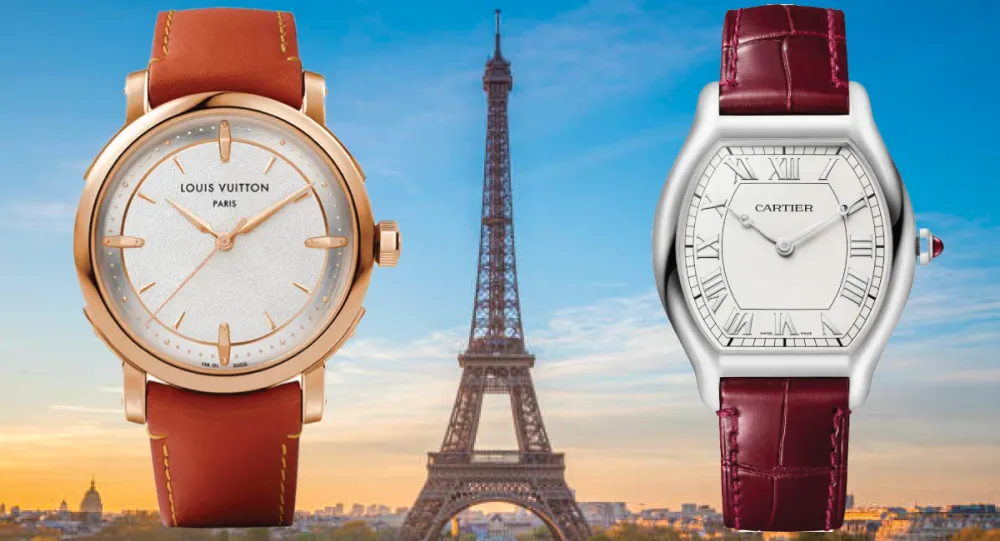
Going to E11even
Miami’s E11even is no ordinary nightclub. The hedonistic spot has spawned residential towers, its own vodka brand and a global cult following. And now, incredibly, there’s talk of creating an entire new district in its image.
Related articles
It’s close to 3.00 am on the Friday before Formula 1 weekend in Miami, and the nightclub known as E11even is heaving. At the owner’s table, just above the dance floor, managing partner Dennis DeGori is showering the crowd below with stacks of cash. “Make it rain,” he says, demonstrating the proper tossing technique so the bills scatter high and wide. Thousands of singles carpet the floor already.
Waitresses hoist magnums of Dom Pérignon, cutting a path through VIPs in the pit. These guests shelled out extravagantly for a prime spot in the club’s throbbing centre. This weekend, the most coveted tables—which encircle an elevated stage, a dance floor, and the DJ booth—will require a minimum tab of US $30,000 (around $46,000) apiece for booze, food, and entertainment. Unlike at most venues, the big spenders here aren’t roped off along the periphery. “I flipped the usual formula,” DeGori says. “At E11even, everyone else is a spectator to the VIP experience.”
A pair of acrobats suspended from ropes contort above the dance floor, their routine pausing the smoke-machined, laser-beamed, strobe-battered madness. Drones buzz around the room, filming everything for the post-party highlight reel.
Just after 4.00 am, DJ Deadmau5—the electronic-dance-music (EDM) superstar who often sells out stadiums—begins his set, filling the 1,250-square-metre club with pulsing sound, the LED eyes of his signature mouse helmet glowing green. Large frosted bottles of E11even-brand vodka are crammed into ice buckets everywhere. Go-go dancers, clad only in race-car helmets and body paint applied to look like F1 driver uniforms, flank the DJ booth. Other young women in lingerie are gyrating on platforms throughout the room. In the middle of it all, a “massage girl” offers head rubs. Down in the pit, a bride-to-be celebrates with friends, flipping back her white veil.
The party rages on well past dawn, as it will the next night, when rapper Travis Scott headlines, and the night after that, when another star, DJ Tiësto, will whip the crowd into a frenzy. The club will earn millions in just three or four days. And night after night, long lines of hopefuls will wait hours to get in, paying anywhere from US$350 to US$100,000 for a table, depending on who’s performing—and the location of that table.
In the decade since it opened its doors in downtown Miami, E11even has transcended the space most nightclubs occupy to become a full-fledged phenomenon, with a cult following and vast global reach. In 2023, E11even-hosted parties popped up at the Cannes Film Festival and the Monte Carlo Grand Prix, exporting the club’s particular brand of unbridled excess as they’d done previously at seven Super Bowls and the 2018 World Cup, in Moscow. Recently, management has been scouting locations for new clubs in Tokyo, London, New York City and Las Vegas. “We’ve had a ton of offers, but it has to be right,” DeGori says.

COURTESY OF E11EVEN
E11even is an unlikely sensation, mixing the risqué, somewhat tawdry, world of bachelor-party lap dances and dollar bills stuffed into G-strings with A-list musical acts and Cirque du Soleil–style theatrics, all packaged with plush gold banquettes and a bone-rattling sound system. It’s an oddly seamless mash-up of manic luxury and sexually charged hedonism, fuelled by large-format bottles of Champagne, vodka and tequila. “It’s many different things to many different people,” says DeGori. “To explain how it works together—you can’t do it.”
Over the years, E11even has spawned brand extensions in music and vodka and NFTs, in millions of dollars in merchandise—mostly US$50 baseball hats—and in the billion-dollar real-estate developments rising on the lots around the club. The 213-metre, 65-storey E11even Residences condo-hotel tower is under construction across the street and expected to open in two years, with interiors from NYC firm AvroKO. A 1,860-square-metre poolside day club will overlook E11even’s new rooftop restaurant, Giselle, a fitting showcase for chef Gustavo Zuluaga’s maximalist cooking. His more-is-definitely-more menu pairs toro-tartare cones, lobster thermidor and wagyu beef tomahawk steaks with a thumping beat. A second, equally tall tower called E11even Residences Beyond will follow, connecting to the first by skybridge; a third is planned for just up the street.
11EVEN might be the first nightclub anywhere to birth a residential tower, which is not all that surprising when you consider its roots. The club’s origins go back to the early 2000s, when co-founder Marc Roberts—a former sports agent from New York who had worked with heavyweight boxing champ Shannon Briggs and NFL star Tyrone Wheatley—began buying land in South Florida. Entering the real-estate- speculation game, he set his sights on Miami’s mostly desolate Park West neighbourhood, snapping up as many abandoned buildings and vacant lots as he could. Roberts didn’t know what the area, tucked between Miami’s Design District and the luxury enclave on the waterfront at Brickell, might eventually become, but he was willing to bet it would be worth a fortune one day. “I just knew it was the best land in Miami,” he says.

ADINAYEV/RENDERS ARX SOLUTIONS
Attempts to transform the area into a 24-hour entertainment district, bringing a bit of Las Vegas into central Miami, had mostly fizzled out by 2012, when Roberts began angling to acquire the Gold Rush, a strip club with a rare 24-hour license to serve alcohol and host nude entertainment, abutting plots he’d already bought. Roberts guessed owner Jack Galardi, an octogenarian gentlemen’s-club mogul known to be a shrewd and intractable businessman, would drive a hard bargain—if he could be persuaded to sell at all.
“Everybody said, ‘That’s the golden piece—of everything you assembled, you’re not getting that. Nobody will get that. He’s not selling, ever,” ‘recalls Roberts. Worried his reputation as a real-estate player might drive up the price, Roberts refrained from approaching Galardi directly. Instead, he sent in a “beard”, a young restaurateur who found Galardi in the hospital, dying of cancer. “I always use a beard,” says Roberts. “I’ve done maybe 60 deals in this neighbourhood; they hear my name, they think it’s lottery time.” The stand-in outlined fantastical plans for a celebrity-backed restaurant—with just enough star power to make it interesting. “I sent my good buddy, he had a little restaurant, just a little guy,” says Roberts. “He said, ‘I want to buy this with an athlete, he’s really hot on it, we better act quick.’ ” Roberts says he even convinced a former client from his sports-agent days (he won’t say who) to lend their name to the ruse.
In the weeks after the Gold Rush deal closed for US$11.9 million, news reports began trumpeting developments coming to Park West and its environs. All at once, a number of long-debated infrastructure improvements were announced: the neighbourhood wasn’t on its way to becoming a new Las Vegas Strip, exactly, but suddenly a train station, a mega-mall (which Roberts had been attached to early on), and a highway extension were all in the works. The value of the land soared overnight.
Roberts and his actual partner on the Gold Rush deal, Michael Simkins—a young power player on the Miami real-estate scene with deep roots in the community (his industrialist father, Leon, had been a major local philanthropist)—decided to keep the strip club going as a revenue source while they considered the fate of the site. They hired a consultant to help locate a third party to run the place for them. “Every strip-club operator in the world contacted us,” says Roberts. “We were the prettiest girl at the prom.”
Rather than partner with any of them and fork over the bulk of the profits, Roberts and Simkins decided to build their own management team. They flew in DeGori, who’d spent more than 30 years running clubs and who came widely recommended, from Vegas. DeGori had opened dozens of venues across the country for his mentor Michael J. Peter—the founder of the Solid Gold and Pure Platinum brands who is sometimes called the godfather of the modern gentlemen’s club—before launching his own spots, including Scores Chicago and the Penthouse Club in Las Vegas. Instead of simply taking over the Gold Rush, DeGori suggested replacing the club with a new sort of hybrid nightlife model, mixing elements of a gentlemen’s club, a classic dance club and a live-music venue. It was an audacious idea, and one he’d been toying with for decades. “I thought, ‘I can put everything together, and it will be spectacular,’ ” he says.

JEFFERY SALTER
Roberts and Simkins, seduced by DeGori’s vision, brought him on board as a partner. Together they began developing plans, eventually gutting the building down to its exterior walls. (To retain the valuable 24-hour license, the club itself couldn’t get any bigger than its original 1,250 square metres.) Simkins told friends he believed it “would be one of the top-five most successful nightclubs in the United States after it opened.” They had their doubts.
“I’m spending all this money and I’m telling people this, and it’s in this neighbourhood no one is really visiting—it was totally off the radar—and they all thought it would be out of business within a year,” Simkins says.
DeGori—who, despite the whole “Make it rain” thing, describes himself as reserved and behind-the-scenes—began assembling a dream team, a sort of Ocean’s Eleven heist crew to help him execute his plan for the club, luring high-powered operating partners, many from Las Vegas, with generous offers.
“Moving bonus, signing bonus—I felt like a first-round draft pick,” says Gino LoPinto, a veteran of the after-hours-club scene in Vegas who came on as the gregarious front man in charge of marketing and talent booking. Daniel Solomon, who had helped Marquee, in Vegas, become the highest-grossing dance club in the country after rising to become the youngest general manager in the Tao group at 25, brought his deep contacts in the EDM scene. A VIP wrangler named Rob Crosoli made the move from Chicago. Even security chief Derick Henry, who had done protection work for Prince, the Jonas Brothers and Mary J. Blige, got a piece of the business. “In a club like this, security is huge,” says DeGori.

COURTESY OF E11EVEN
As what would turn out to be a US$44 million build-out continued, the owners and managing partners brainstormed ideas for a name. They wanted something open-ended, vague, hard to define. It wasn’t a classic dance club, concert venue, lounge or cabaret theatre. It was all of those things, and none of them.
The address was on 11th Street. DeGori, whose daughter had just turned 11, began seeing the number everywhere. “I really like it, because it says nothing,” he explains. They couldn’t trademark a number, but a distinctive spelling, E11even, would work. In the build-up to opening, they erected cryptic billboards across Miami. “Whatis11.com” followed by “It is what you think it is.” According to LoPinto, “We never explained what it was.”
A pre-opening party, announced in the New York Post, doubled as a casting call for “60 sexy beach bodies” to appear in the Entourage movie—the film’s writer-director, Doug Ellin, was an old friend of Roberts’s. Invitations to other launch festivities, sent to several hundred VIPs, arrived in black boxes that played opera music when opened. Inside was a gold mask and a silver key to the club. “We sent one to Steve Wynn, to Trump, to a lot of people we knew wouldn’t come,” says LoPinto. Another list, of people more likely to show up and spend money, received an American Express–style black card loaded with US$11,000 in credit to be used during the club’s first year in business.
E11even, billed as the “world’s first and only 24/7 Ultraclub,” was originally open non-stop seven days a week. (Hours were later curtailed by the pandemic, and now the club is open around the clock from only Wednesday to Monday.) The first few months were a struggle. “We were bleeding money,” says Roberts, “and then all of a sudden, it just started clicking.” Soon, celebrities began showing up. Leonardo DiCaprio made an early appearance. One night, Miley Cyrus jumped onto the pole in the middle of the pit. Idris Elba moonlighted in the DJ booth.

COURTESY OF E11EVEN
After Usher performed during the club’s first New Year’s Eve, E11even began booking some of the biggest names in hip-hop and electronic music, from Diplo to DJ Marshmello, Cardi B. to Snoop Dogg. Drake, who rang in the New Year in 2016, was the first artist to perform in the pit, surrounded by fans, pioneering the up-close-and-personal staging that has since become a hallmark of E11even at its wildest. (Altogether, Drake has played the club seven times.)
For the first few years, as the business’s fortunes began soaring, Roberts and Simkins remained mostly hands-off—more landlords than operators. Simkins, active in the civic affairs of his Miami Beach community, worried about the reputational risk of attaching his name to the club and the potential strain on his marriage. His wife, Nikki, who’d been his high-school sweetheart, “was freaked out,” he says. “It was one thing to buy it and lease it, which she was on board for, but this shift into partnering on the business was heavy for her. So certain promises were made… that I would only go to the club with her, and that was the rule for the first six years.”
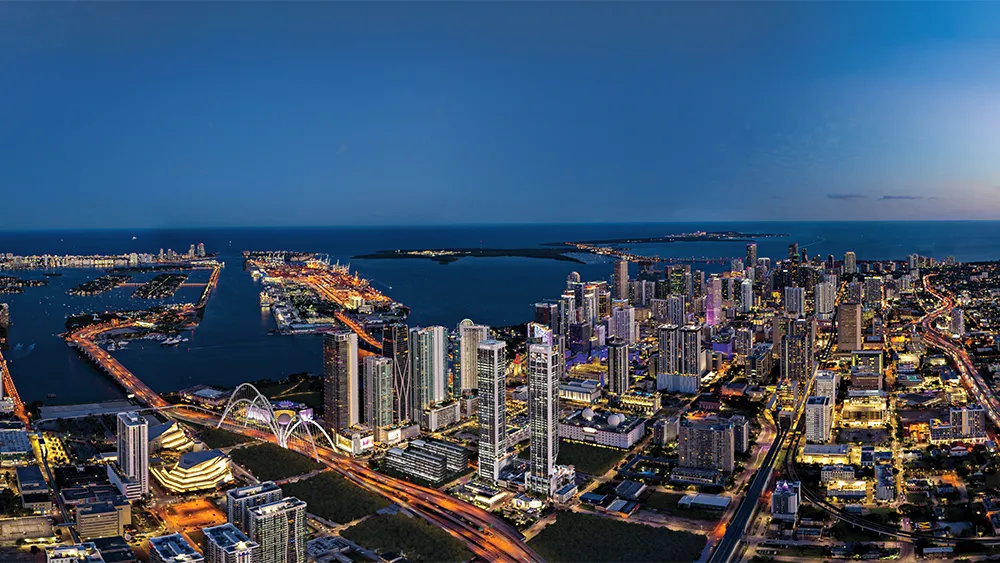
COURTESY OF E11EVEN
But as the cult of E11even soared, the stigma soon faded. “People were connecting emotionally with the brand, superfans were developing,” Simkins says. Eventually Nikki, a former diamond dealer, took on a role in the business herself, helping to launch the club’s vodka, produced in Florida under the E11even label, as CEO of the brand’s spin-off company.
The E11even management team, always quick to capitalise on new trends, jumped on the cryptocurrency craze early on, as Bitcoin mania engulfed Miami during the rise and fall of Sam Bankman-Fried’s house-of-cards exchange, FTX. E11even became the first nightclub in the country to accept Bitcoin. During Miami’s inaugural Bitcoin Conference, the club was often packed with big spenders flashing their crypto wallets. E11even even sold a special diamond-encrusted Bitcoin hat for US$50,000.

In late 2021, the company spent nearly US$400,000 acquiring a Bored Ape Yacht Club NFT—No. 11, of course. (The value of Bored Ape NFTs has since plummeted.) E11even’s Ape became the new mascot and the launching pad for a label, E11even Music, run by LoPinto. (It later released a track from a new EDM artist, 11Ape, an in-house creation who performs anonymously wearing a Bored Ape mask.) In the spring of 2022, the club released its own collection of 1,111 NFTs. Buyers were granted membership in the E11even Captain’s Club and special access to the facilities, among other perks, for 3 ETH (about US$7,900 at the time).

COURTESY OF E11EVEN
The halo effect of an unforgettable evening may help explain why so many of the club’s business partnerships have succeeded. Real-estate developer Ryan Shear, principal of PMG, which has built many condo towers in Miami and New York, was having a big night out at E11even a few years ago when he asked to meet Roberts, who was seated upstairs at his usual table overlooking the pit. Soon they were tossing around ideas for an E11even high-rise on the land Roberts and Simkins owned across the street. “We’d kill it,” said Roberts, selling the proposal hard.
A few meetings later, Simkins and DeGori were in on the deal. Soon the club’s managing partners also signed on, enthusiastic about expanding the debauched spirit of E11even to a much bigger platform. “There’s not really a Vegas-style property in Miami—great beach club, great spa, great food and beverage offerings, 24-hour lobby bar,” says LoPinto of the hybrid condo-hotel plan.
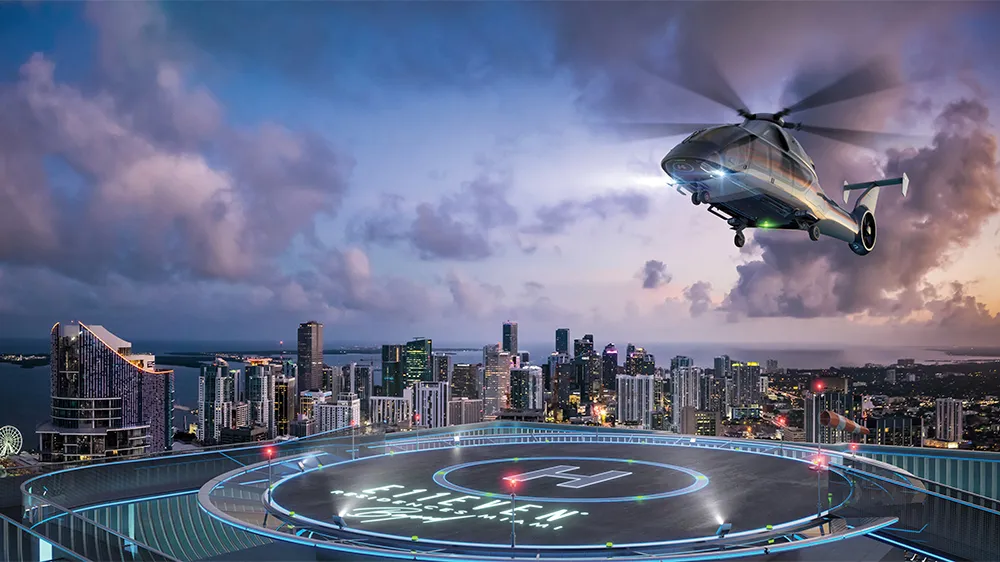
COURTESY OF E11EVEN
The first units went on sale in January 2021, a year and a half before a foundation was poured. All were sold fully furnished, so they could function as hotel rooms when not in use by their owners. A few deep-pocketed E11even fans bought up entire floors. Prospective buyers were tantalised by a whole set of perks, including access to a beach club on South Beach, about a 20-minute drive away, and to the tower’s many amenities, among them a 930-square-metre spa and wellness studio offering Ayurvedic treatments designed by Deepak Chopra (his first residential project), a cigar club and a restaurant. The 449-unit tower, containing everything from US$300,000 studios to US$10 million penthouses, sold out in six months.
A second tower hit the market in late 2021, with plans for condos, a private members’ club, and a helipad on top. Sibling influencers Jake and Logan Paul both reportedly bought penthouse units, with listing prices of US$20.5 million apiece, off-plan. A third tower went on sale a few months later. A fourth isn’t out of the question, says Simkins, once the last one sells out.
“Come back in a couple of years—you’re not going to believe your eyes,” says Roberts, a born salesman, of the partner s’plans to transform the area surrounding the club into one massive brand extension. Recently, they have started referring to it as District E11even. “This is a whole new city,” he says. “This will be the most famous entertainment street in the world when we’re done with it.” ●
Click here to subscribe to Robb Report ANZ.
Subscribe to the Newsletter
Recommended for you
Watch This Space: Mike Nouveau
Meet the game-changing horological influencers blazing a trail across social media—and doing things their own way.
By Josh Bozin
July 22, 2024
5 Lounge Chairs That Add Chic Seating to Your Space
Daybeds, the most relaxed of seating solutions, offer a surprising amount of utility.
July 22, 2024
You may also like.
You may also like.
8 Trés Chic French Watches Perfect for Commemorating the Olympics, from Breguet to Cartier
Chanel, Cartier, Louis Vuitton, Breguet, and more make up quite a stellar list of French watches perfect for remembering the Paris Olympics for decades to come.
The opening ceremony for the 2024 Olympic Games takes place in Paris on July 26th. Whether or not you’re attending the games, one way to celebrate the start of the world’s biggest sporting event, and to show some espirit de corps with your fellow Francophiles, is by treating yourself to a French watch. Of course, you could go for the very Swiss Omega Speedmasters that came out to commemorate the Paris Olympics earlier this year, and that would be a tasty choice, but perhaps something more French is in order.
Also, if you’re going to be in Paris for the games (or anytime really) we have an excellent guide to the best watch boutiques in Paris for you, as well.
While not all of the timepieces highlighted below were made in France (so few watches are anymore), they each have deep connections to Paris, French watchmaking and/or Gallic style. And, as we’ve written elsewhere, French watchmaking has a long-standing and powerful influence on Swiss watchmaking. In fact, it was in Paris the Louis Cartier perfected the Tank that would go on to make wearing a watch on the wrist popular in the first place, this during the 1920s and 30s. And, of course, Cartier watches are all the rage these days, including the rather tiny Tank Mini, which made big waves at Watches and Wonders this year, as well as the Tortue, which made our best-of list this year.
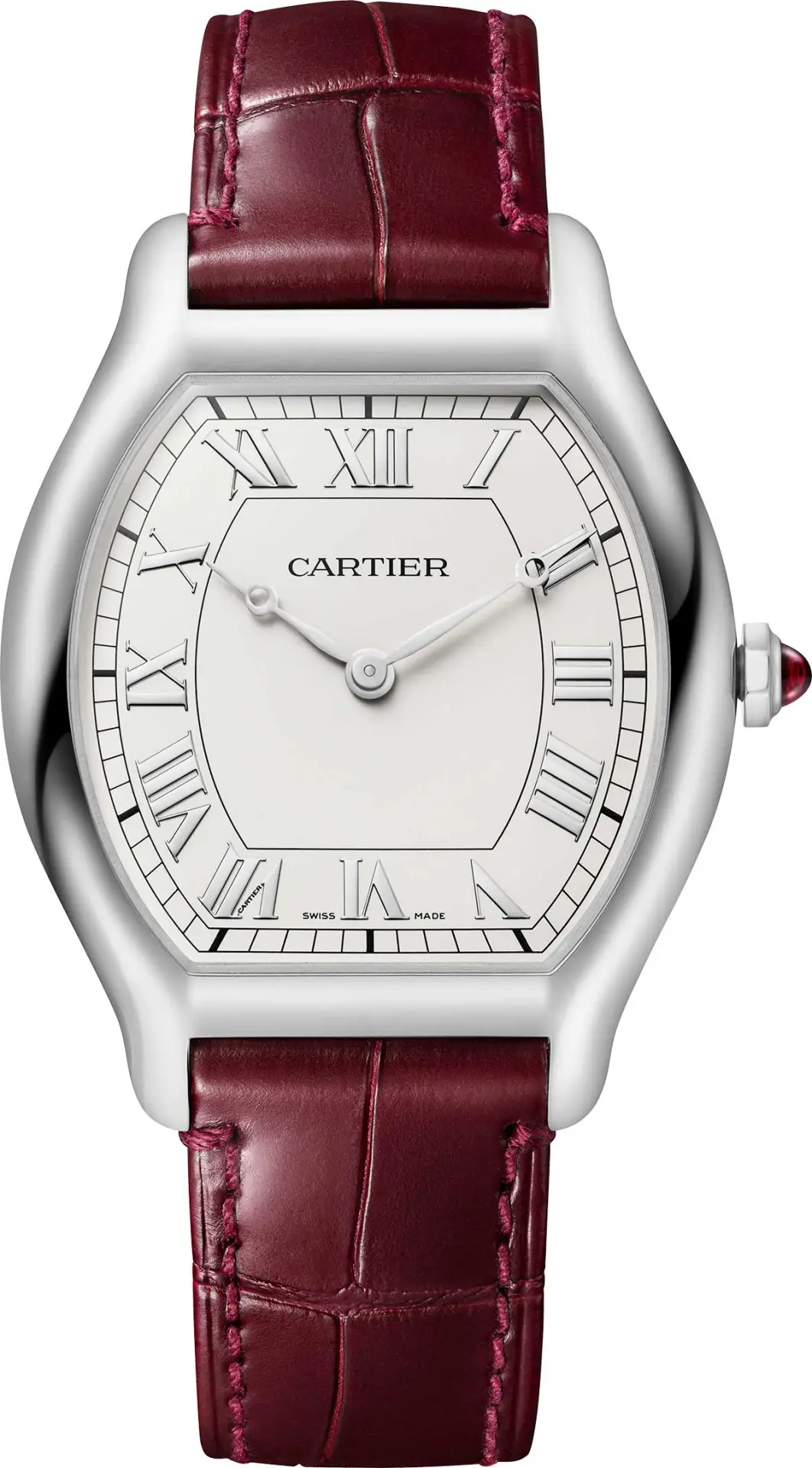
Indeed, the Parisian horological roots run deep, but it’s not all Cartier. From Louis Erard’s whimsical collaboration with French interior-designer-turned-watchmaker Alain Silberstein to the dreamy, avant-garde designs of Paris-based Trilobe, there’s something for everyone in this mix.
Of all the watches Cartier introduced at Watches and Wonders Geneva this year, the Tortue re-edition was the most talked-about. Even older than the Tank, the tortoise-shaped model (born in 1912) is now available in a monopusher chronograph as well as the simpler “hours and minutes” platinum version shown here. Limited to 200 pieces, the stylish and shapely Tortue, which comes out in September, makes clear that even though Cartier manufactures all of its watches in Switzerland, the Paris-based brand is French to its core. $54,770.
Breguet Classique Double Tourbillon “Quai de l’Horloge” 5345
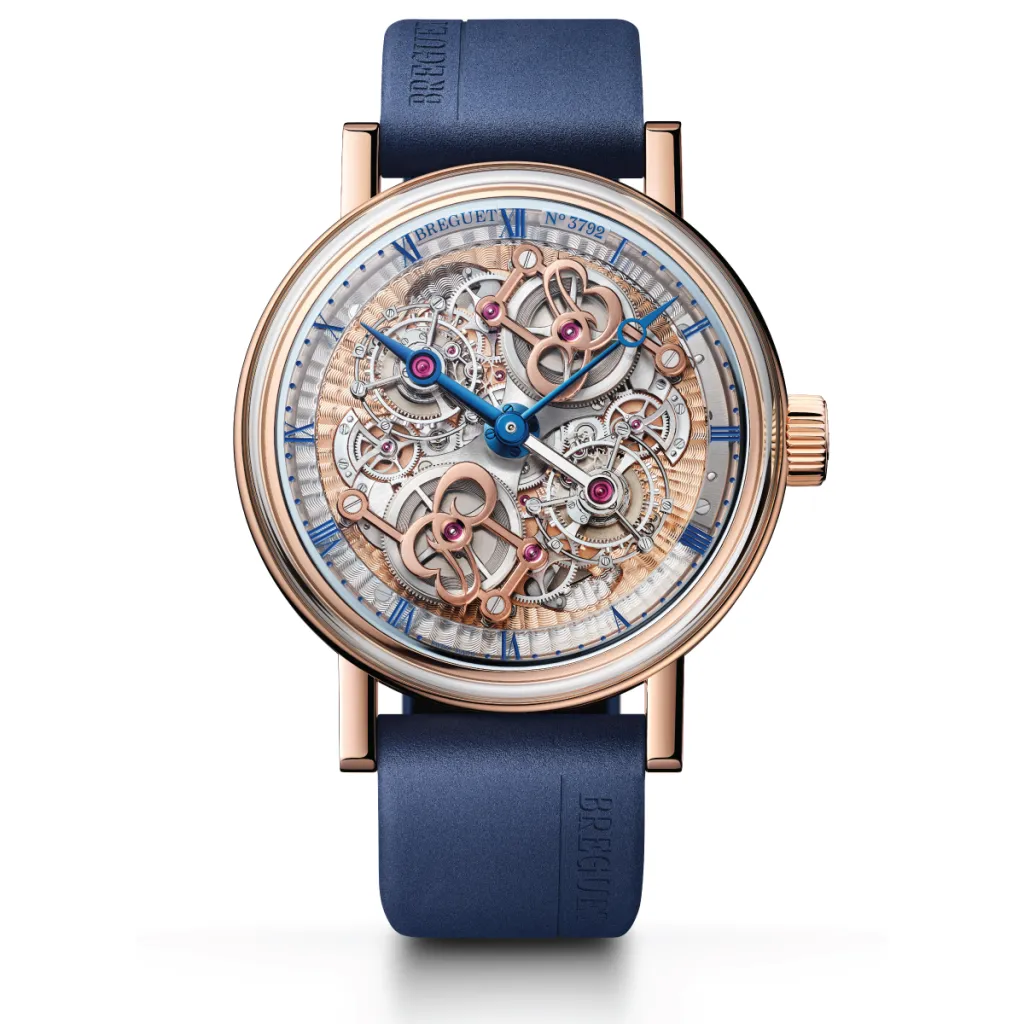
Although Breguet is now based in Switzerland, its namesake, Abraham-Louis Breguet, inventor of the tourbillon as well as the now-ubiquituous Breguet hands and numerals, made his mark on horology in Paris, where he maintained a workshop at 39 Quai de l’Horloge. The brand pays tribute to that history with its latest tourbillon, a 46 mm rose gold wristwatch equipped with not one, but two of the whirling mechanisms. Be sure to admire the engraving on the back of the movement, which depicts an aerial view of the workshop. C’est magnifique! Price on request.
Trilobe Les Matinaux L’Heure Exquise Dune Edition
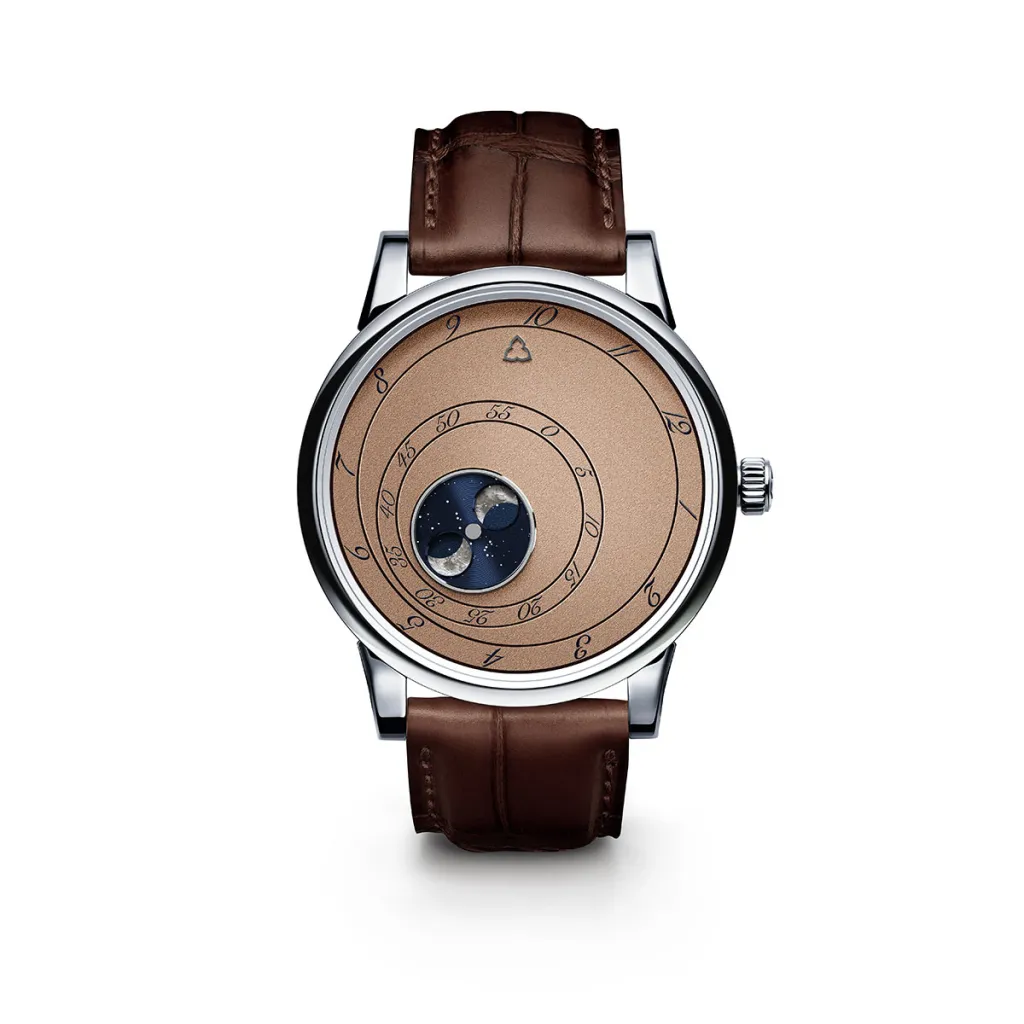
In 2018, Paris-based Trilobe introduced its Les Matinaux (“The Morning”) collection, and with it, a new way of telling the time. Employing a wandering display, the watch used three discs that rotated counterclockwise and three fixed pointers to indicate the hours, minutes and seconds. Named after a collection by the midcentury French poet René Char, the series recently spawned a new sand-colored Dune edition that marks the brand’s entrée into the world of complications. Limited to 100 pieces, the model, dubbed L’Heure Exquise (“The Exquisite Hour”), features a moonphase complication that evokes the orbit of the Moon around the Earth against the backdrop of a starry night sky. $21,995
Chanel Monsieur de Chanel Édition Superleggera Intense Black
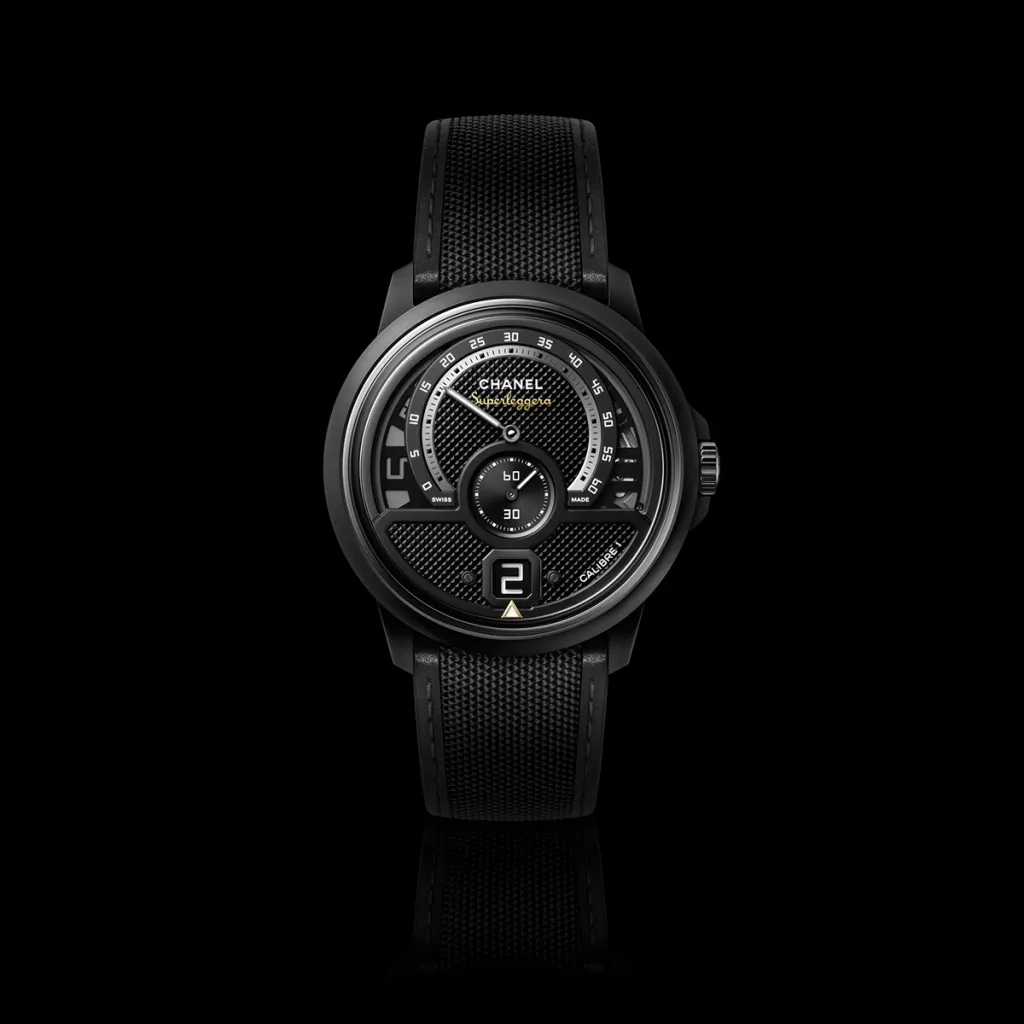
Arguably the Frenchiest brand on our list, Chanel made a name for itself as a high-end (as opposed to fashion) watchmaker in 1999, when it introduced its signature timepiece, the J12 (in unusual-for-the-time ceramic, no less). At Watches and Wonders Geneva in April, the brand upped the ante with its latest Monsieur timepiece, the Superleggera Intense Black, a limited edition of 100 pieces inspired by car racing. Housed in a matte black ceramic and steel case, the watch features a matte black guilloché dial and comes on a black nylon strap with black calfskin leather trim and lining. $69,651
Hermès Arceau Grand Tralala Brides et Mors
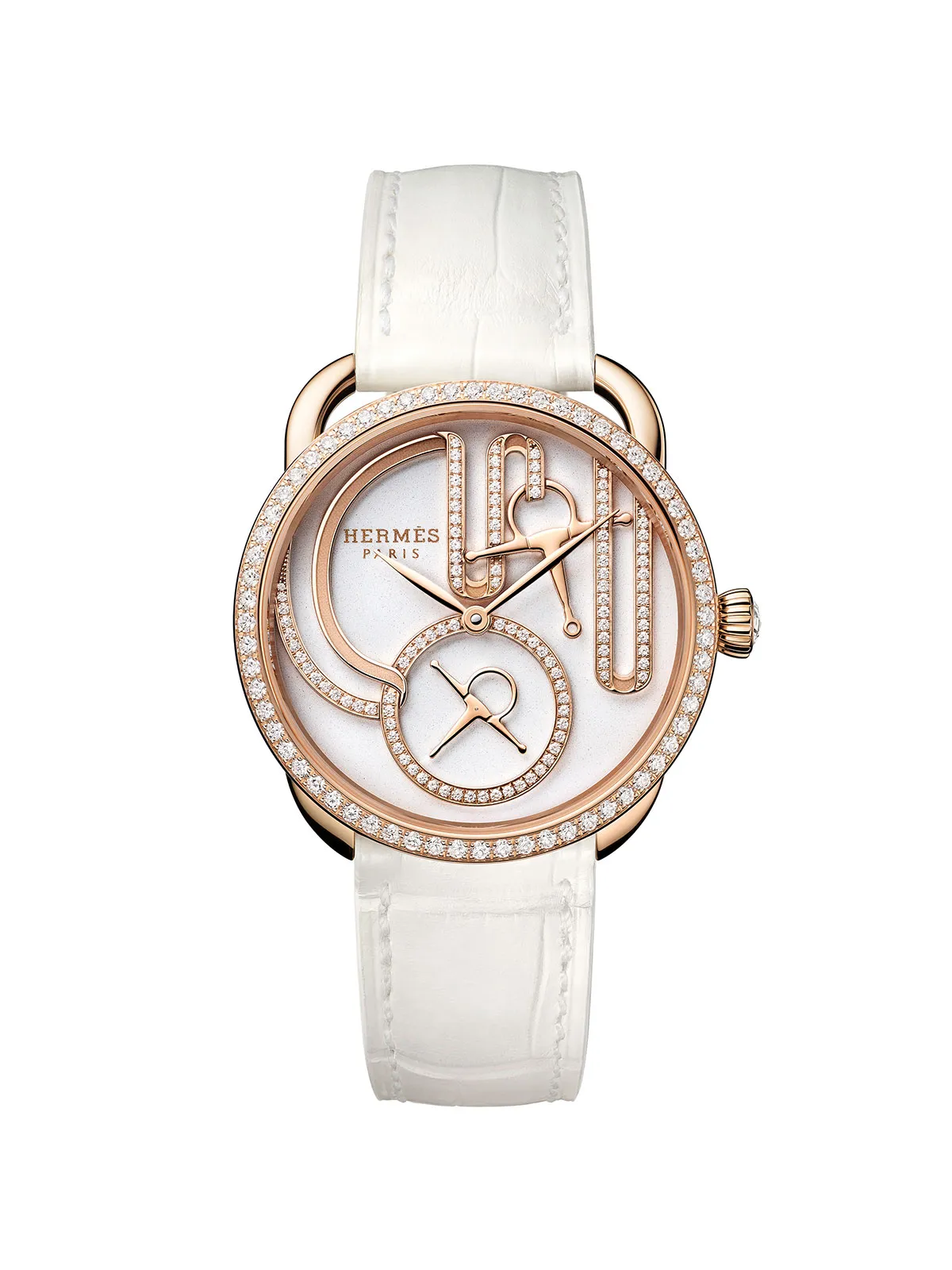
Like so many of Hermès’s most sought-after watches, the new 34 mm Arceau Grand Tralala Brides et Mors traces its design to another Hermès product, in this case the Grand Tralala silk scarf created by French artist Virginie Jamin. Patterned after the prestigious harnesses worn by the Royal Hungarian Bodyguard in the 19th century, the graphic design evokes the look of intertwined bridles and bits within a rose gold frame. Note the bit-shaped seconds hand! $72,172
Louis Erard x Alain Silberstein Smile-Day
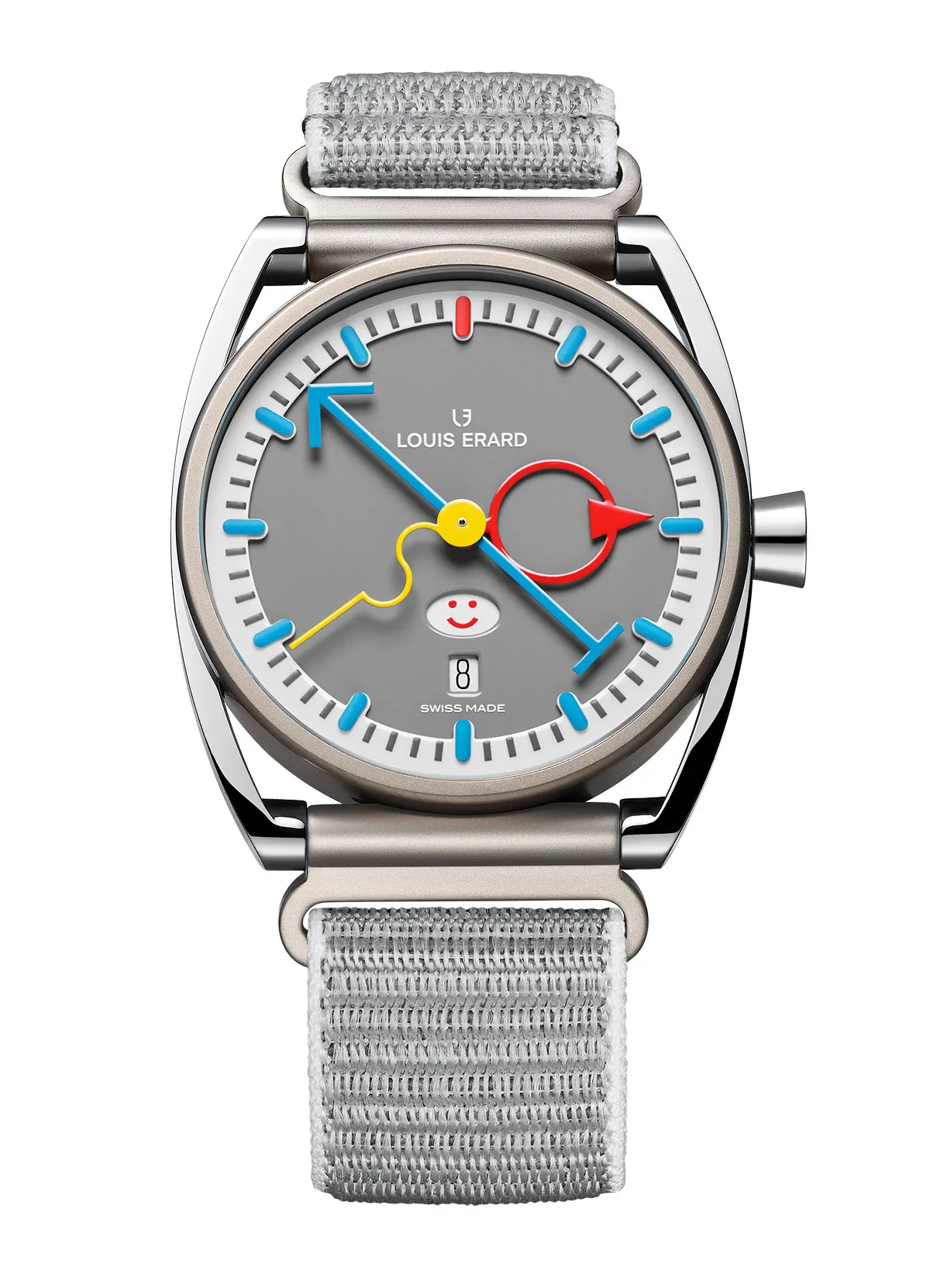
Imagine if Rolex’s much-talked-about emoji watch of 2023 had a child with the Memphis Group, a collective of Milan-based architects and designers who became known in the 1980s for their use of bright primary colors and bold patterns. That’s a quick way to describe the new 40 mm Smile-Day limited edition in titanium from Swiss watchmaker Louis Erard, whose latest collaboration with the iconoclastic French watchmaker Alain Silberstein reflects his signature whimsy. Silberstein was trained in graphic design and architecture in Paris by former members of Germany’s Bauhaus faculty, and he takes his whimsy very seriously. Between the aperture at six o’clock featuring a sliding carousel of seven emojis, the yellow squiggly seconds hand and the nostalgic color scheme, the piece is an instant classic. $8,019
Louis Vuitton Escale
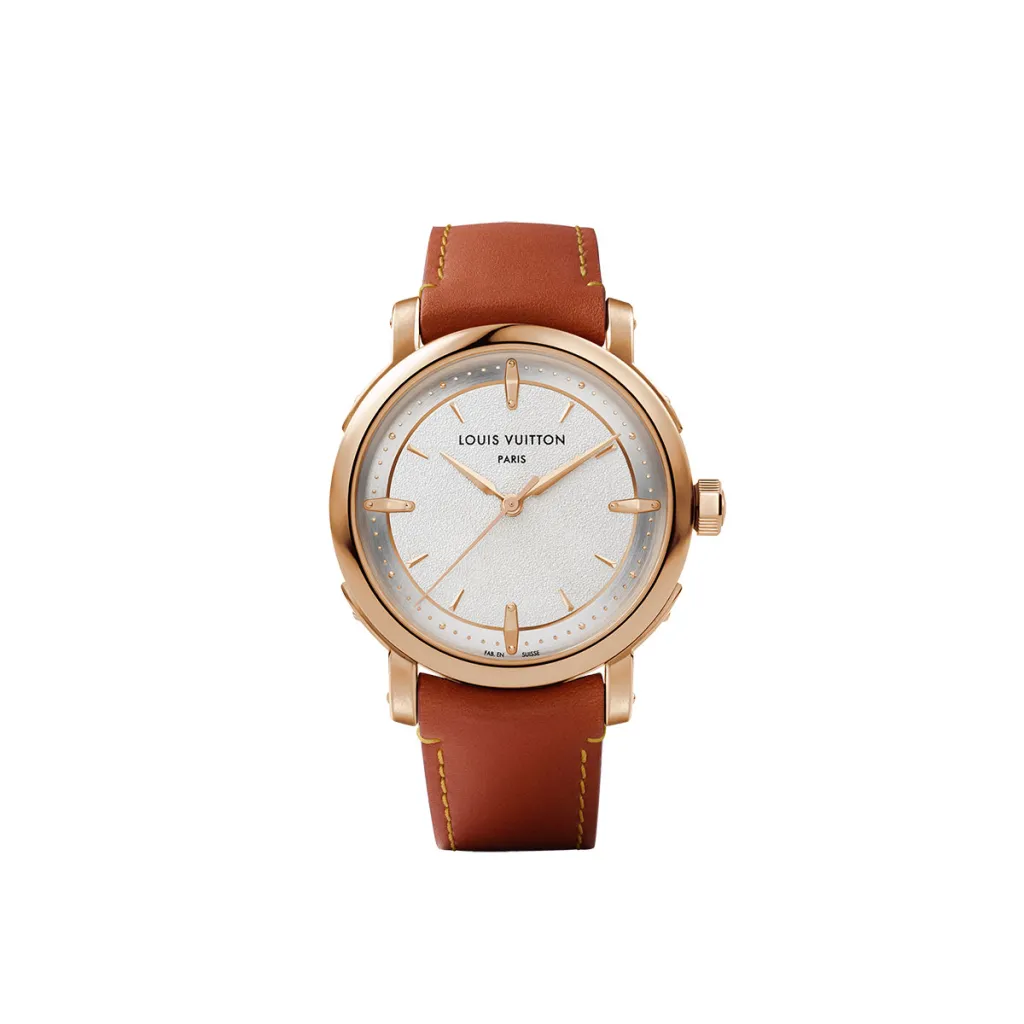
The dress watch revival continues with the new Escale by Louis Vuitton, an elegant timepiece honoring the 10th anniversary of the Escale collection (its first time-only, three-hand watch). Of the four new models in the line, two come in rose gold (like the 39 mm automatic model shown here), while the other two come in platinum. The former feature textured dials designed to evoke the suppleness and tactility of the Louis Vuitton Monogram canvas on metal. Equipped with a chronometer-certified movement with 50 hours of power reserve, the rose-gold Escale comes on a calf-leather strap. In a press release, the brand made sure to emphasize the model’s roots: “Just below the 12 o’clock hour marker, under the Louis Vuitton logo, is one word that encapsulates everything there is to be known about the Escale’s creative rebirth: Paris.” $40,324
Bell & Ross BR 03 Diver Full Lum
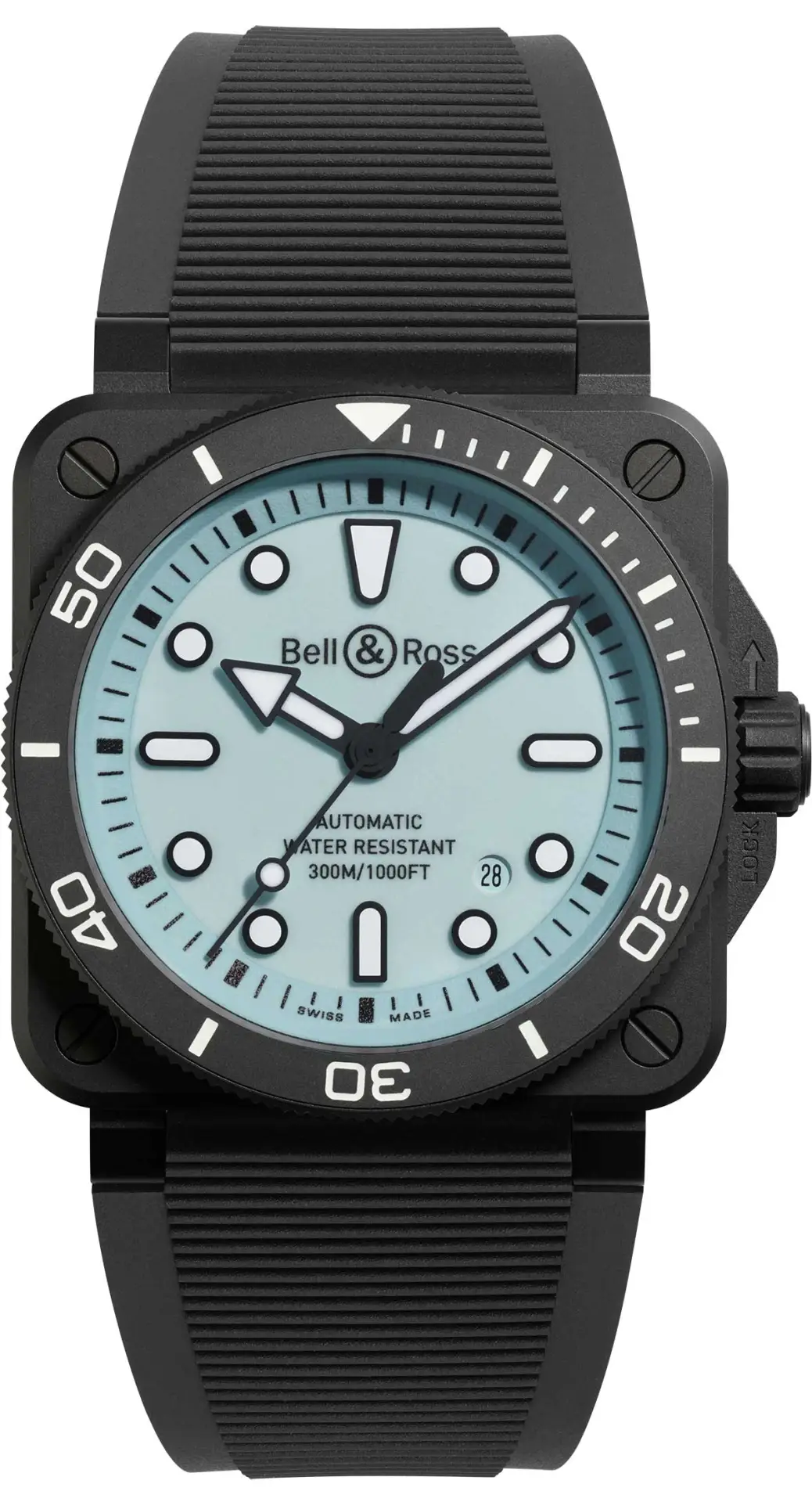
The BR03 Diver from Paris-based Bell & Ross celebrates its seventh anniversary this year. Recognised as the first square diving watch, the 2024 edition is new in more ways than one. Composed of five new models, including the full lume version with a pale blue dial shown here, the series is equipped with an improved automatic movement boasting 54 hours of power reserve, new typography, redesigned hands for optimal legibility and a new adaptable strap. $8,248
You may also like.
How Paris’s Dining, Hotel and Art Scene Got Their Groove Back — Just in Time for the Olympics
The French capital’s cultural life was already on the upswing. Mix in a major global sporting event, and it’s now ready to go toe to toe with any city in the world.
Host cities of modern-day Olympic Games have gotten into the competitive spirit by trying to stage the most spellbinding, over-the-top opening ceremony on record. Beijing enlisted 2008 drummers. London featured James Bond escorting Queen Elizabeth II. All Rio needed to wow the crowd was Gisele, who turned the stadium into her personal catwalk, strutting the length of the field solo. But only Paris could make the unprecedented gamble that the city itself is spectacular enough to be the star of the show.
If all goes according to plan when the Summer Olympics alight in Paris this July, the opening ceremony will play out like a Hollywood epic: timed to coincide with the sinking of the sun, an open-air flotilla of boats will ferry the athlete delegations on the Seine, sailing toward the sunset as hundreds of thousands of spectators cheer from either side of the river’s banks and the bridges above, all bathed in the amber afterglow.

Nico Therin
It will mark the first time the ceremony will be held outside a stadium, let alone on a waterway. So too many of the events themselves, instead of being mounted in mostly generic stadiums on the outskirts of the city, will take place in the heart of Paris, reframing the French capital in a way that locals and visitors alike have never experienced—and that’s sure to dial up the promise of pageantry and emotion.
The Eiffel Tower’s latticed silhouette will serve as the backdrop for beach volleyball at Champs de Mars. Place de la Concorde, where more than a thousand people (including Louis XVI and Marie Antoinette) had their heads lopped off during the French Revolution, will be the site of newly admitted Olympic sports such as skateboarding and breakdancing. And though Olympic swimmers have raced in pools since 1908, this year’s athletes are slated to compete in the river itself. (Competitions will also take place in cities across France, from Lyon to Marseille, and Tahiti in French Polynesia will host the surfing event.)
The specs are ambitious and inventive, and in some ways could restore the city’s reputation for audacity. Because while the City of Light may be known as the cradle of fashion, culture and gastronomy, not too long ago it was also regularly accused of slipping into a lazy, even smug, complacency—stuck in its ways, resting on the laurels of its storied past.
In the food world, those doldrums translated into controversial snubs from the influential World’s 50 Best Restaurants list, known for flushing out avant-garde chefs. The French Michelin Guide, once considered the ultimate arbiter of fine dining, suddenly seemed staid and irrelevant. London and Berlin took Europe’s centre stage in art and design. Even President Emmanuel Macron described his fellow countrymen as resistant to change, much to the ire of those fellow countrymen—and countrywomen.

But influential creatives and Parisians say that in the years leading up to the Games, and particularly since the pandemic, something has shifted. “I really think that during the last 10 years, Paris opened itself to more new things, for different trends,” says Hélène Darroze, the acclaimed chef whose six restaurants include Michelin two-star Marsan in Paris and her three-star namesake at The Connaught in London. “Paris is happier than before, more joyful than before.”
There’s a giddy sense of anticipation, says the illustrator Marin Montagut, who has collaborated with Le Bon Marché and the Ritz Paris and owns an eponymous boutique in Saint-Germain-des-Prés where he sells hand-painted glassware and porcelain decor. “It feels like Paris is trying to look very, very pretty for a very important evening. She’s been getting some plastic surgery and is trying to get ready in time,” he says with a chuckle. “There’s just a lot of effervescence in the city.”

Nico Therin
For better or for worse, some of the credit for that renewed vitality belongs to the light-as-soufflé Netflix series Emily in Paris, which quickly became the collective escapist fantasy for viewers around the world who were grounded by the Covid-19 virus. Another part of that newfound energy, though, can be traced to the frenzied building of luxury hotels, restaurants, galleries, museums and boutiques over the past few years, including Montagut’s own Paris-themed shop, which he opened in 2020.
In the past three years alone, 25 new five-star hotels debuted across the city, bringing the total to 101. Noteworthy newcomers include Madame Rêve, Kimpton St. Honoré Paris, Château des Fleurs, Maison Proust, LVMH’s Cheval Blanc Paris, and Chopard’s first boutique hotel here, 1 Place Vendôme. The dual autumn 2023 openings of Le Grand Mazarin and La Fantaisie hotels marked the Paris debut of Swedish designer Martin Brudnizki, whose playfully modern, maximalist and flamboyant aesthetic injected colour and character into Paris’s elite hotel scene.
In parallel with the growth of traditional hotels, new players in the luxury rental market are emerging, joining the likes of Le Collectionist and Belles Demeures. Founded in 2020, Highstay rents out luxury serviced apartments equipped with kitchens and living spaces. The firm’s current portfolio includes 36 apartments in areas such as the Champs-Élysées and Saint-Honoré, and another 48 are under construction—all of which it owns. There is no check-in (guests are sent digital access codes) and all concierge requests, including housekeeping and travel reservations, are made via live chat on a dedicated guest portal. “The goal is that guests get the real Parisian experience and feel like an insider, like a city dweller,” says general director Maxime Lallement.
The idea of making Paris as welcoming as a second home is also what drives the luxury real-estate market for foreign buyers, particularly Americans, says Alexander Kraft, CEO of Sotheby’s International Realty France-Monaco. He sees 2024 as a “transition year” and says that the local market is moving at two different speeds: while demand for properties between roughly $1.5 million and $8.5 million has cooled, high-end properties between about $17 million and $85 million continue to sell fast among buyers from the Middle East. Kraft predicts the market will pick up in 2025 following the US presidential election. “Paris is one of those real-estate markets that is eternally popular,” he says. “Contrary to other international cities, it really has broad appeal.”

Nico Therin
Montreal-born, New York–based interior designer Garrow Kedigian is one of those frequent visitors who decided to take the leap and buy his own pied-à-terre in Paris a few years ago, after a lifetime of travelling back and forth for both work and pleasure.
As a part-time resident, Kedigian says he too has noticed a palpable shift in the city’s vibe, which he attributes to a renewed appreciation for tourists following their absence during the pandemic, as well as an “international flair” that has given the city a fresh spark. “There’s a lot more cultural diversity than there was before,” he says. “In that respect it’s a bit like New York. And I think that now the interface between Paris’s unique flavour and the international populace is a little bit smoother.”
For Montagut, one of the best examples of this synergy can be found in Belleville, in the city’s east end, where independent artists, musicians and other urban creatives rub shoulders in Chinese, African, and Arab restaurants and businesses. “There’s a social and cultural diversity here, and for me this is really important,” Montagut says. “If Paris was just the 6th arrondissement, it would be boring.”
The eastern edge of Paris is also one of the preferred neighbourhoods of Michael Schwartz, the marketing and communications manager for Europe at French jewellery house Boucheron. A recent New York City transplant, he is drawn to the burgeoning number of gastronomic gems far from the madding tourist crowds.

Nico Therin
He points to sister restaurants Caché and Amagat (the names mean “hidden” in French and Catalan, respectively), discreetly located at the end of a cobblestoned cul-de-sac, as favourites. With backgrounds in fashion and advertising, the Italian duo who run them have attracted equally fashionable locals to this hitherto quiet part of town. Caché serves up fresh Mediterranean seafood dishes, while next door, Amagat specialises in Catalan tapas.
Then there’s Soces, a corner seafood bistro on rue de la Villette, where you might find Jean-Benoît Dunckel, who co-wrote the score to Sofia Coppola’s film The Virgin Suicides when he was part of the electronic-music duo Air (Dunckel’s recording studio is in the area), or the French designers behind the Coperni fashion line, Sébastien Meyer and Arnaud Vaillant. “This is a really special restaurant,” says Schwartz. “It’s frequented by really cool creatives, designers and musicians, and it’s kind of a destination restaurant for most people because it’s not central.”
What makes Paris’s dining scene so exciting now, according to Stéphane Bréhier, editor in chief of French restaurant guide Gault& Millau, is a sense of fearlessness among younger chefs who reject the traditional trajectory that begins with a lowly stage in a Michelin-star kitchen. What’s more, visitors are likewise foregoing Michelin establishments in favour of newer, more experimental dining spots. “Over the last few years, there’s been a profusion of young chefs who don’t want to work for other people and are daring to set up their own shop,” Bréhier says. “The gastronomic scene is booming in Paris.”

Nico Therin
These bold, emerging chefs feel less bound not only to their elders but also to French cuisine itself. “It has changed a lot,” says Hélène Darroze, who opened Marsan, her first Parisian restaurant, 25 years ago. “The new generation travelled a lot—in South America, for example, in Asia—before opening a restaurant or being a head chef somewhere. They opened themselves to other cultures. This is why the culinary scene at the moment is very interesting in Paris; because it’s a mix of very famous chefs with Michelin stars but also young chefs who don’t care about Michelin stars—they just want to explore so many fields.”
The ever-growing importance of social media and its insatiable hunger for envy-inducing images is driving another major trend in the dining scene: rooftop spots, including Mun and Girafe in the Golden Triangle, the area bordered by avenues Montaigne and George V and the Champs-Élysées. “A lot of rooftops have opened in Paris, where before they were pretty much nonexistent apart from the Eiffel Tower and the Montparnasse Tower,” says Dimitri Ruiz, head concierge at Hôtel Barrière Fouquet’s Paris on the Champs-Élysées.
Five-star Right Bank hotels SO/ and Cheval Blanc Paris have watering holes that offer sweeping vistas of the Seine. But perhaps the most coveted perch during the opening ceremony will be the Champagne bar at La Tour d’Argent restaurant, which boasts unobstructed views of the Notre-Dame Cathedral and the Seine. (And yes, someone already had the idea to book it for a private event.) Famous for its signature pressed duck as well as for hosting monarchs and heads of state, the historic restaurant recently underwent a major renovation that included the addition of the aerie, which opened late last summer. “It’s only been in the last 10 years or so that Paris has been developing rooftops, and it’s really taking off like wildfire,” says third-generation owner André Terrail.
Paris’s venerated fashion industry has also found ways to innovate, with fresh faces keeping their fellow couturiers on their toes and the shopping options enticing. In 2022, for example, Simon Porte Jacquemus opened his first boutique in the city on avenue Montaigne—home to Gucci, Chanel, and Prada, among other venerable names—and in March, at the age of 34, became France’s youngest fashion designer to be named a Chevalier de l’Ordre des Arts et des Lettres for his contributions to the field. That kind of success has a ripple effect in the creative community.
“Almost every street has the name of an artist or a politician,” says Charaf Tajer, the Parisian-born creative director behind the London-based Casablanca sportswear line. “So the city reminds me always that the people who came before me, who walked those streets, created the future in a way. As much as [Paris] seems stuck in time visually, you can also feel the energy of people creating the present.”
Interior designer David Jimenez, whose 2022 book Parisian by Design compiles his Francophile projects, moved to the city in 2015 and spent his first few years living near the Champs-Élysées, which he says has undergone a noticeable revival. Along with Jacquemus’s arrival, new luxury openings or expansions—including Burberry, Saint Laurent, Bottega Veneta, and Panerai—and city-led greening efforts are bringing Parisians back to the 8th arrondissement, long dismissed as an overcrowded tourist trap where fast-food and fast-fashion chains had colonised the once glamorously luxe avenue. Now, Dior’s captivating Peter Marino–designed museum draws legions of fans, while the city has been busy planting more trees, renovating gardens and repairing damaged sidewalks as part of a long-term embellishment plan. And on the first Sunday of every month, the entire length of the Champs-Élysées becomes a pedestrian-only promenade. “It’s an exciting evolution in a part of the city that seemed sleepy and perhaps lost its way a little bit,” Jimenez says. “Now there’s a thrust forward.”

Nico Therin
The thriving fashion houses are responsible for more than maintaining the city’s unparalleled reputation for chic. To a large degree, they have also helped revive its status as an art capital. The billions generated by LVMH (parent of Louis Vuitton, Dior and Berluti, among others) and Kering (Alexander McQueen, Gucci, Bottega Veneta, et al.) funded the extraordinary contemporary art collections amassed by their founders, Bernard Arnault and François Pinault, respectively. The rivals rewarded their hometown with two museums, Fondation Louis Vuitton and Bourse de Commerce, that have helped make it a leader in contemporary art.
Also lending a hand: Brexit, which persuaded many international galleries to brush up on their French. One of the most talked-about recent additions is the powerhouse Hauser & Wirth, which opened in a 19th-century hôtel particulier near the Champs-Élysées last year. David Zwirner arrived in 2019, Mariane Ibrahim in 2021, and Peter Kilchmann the following year, all joining long-established Parisian galleries including Perrotin and Thaddaeus Ropac. The City of Light even snagged its own coveted annual installment of Art Basel: Paris+, which now runs every October in the Grand Palais.
“Quite frankly, Paris has been putting up some of the most incredible exhibitions in institutions in Europe,” says Serena Cattaneo Adorno, senior director at Gagosian. “And a lot of private collectors have also decided to open spaces in the city, creating a great dynamic between public and private galleries.”

The always-savvy Gagosian, on rue Ponthieu, has hit upon an authentic tie-in with the Games: a summer exhibition featuring Olympic posters created over the years by celebrated artists from Picasso on up to Warhol, Hockney and Tracey Emin. “Once you start digging, you find that a lot of artists have reflected on sports and the engagement of the body,” Cattaneo Adorno says. “It’s just a really pure and beautiful message about how art and sports have dialogues that can be somewhat surprising.”
A few months out from the festivities on the Seine, interior decorator Jimenez sums up the mood of many locals, saying (only half-jokingly), “I think for most Parisians, there’s a sense of curiosity, optimism, excitement—and an exit plan, in that order.”
While polling shows that nearly half of Parisians intend to vacate the city during the games, Jimenez notes that he will be watching the opening ceremony with friends who live in an apartment overlooking the Seine. “I want to be part of the excitement. I want to see as much as I can and be energised by this very special and unique moment,” he says. “It’s a once-in-a-lifetime opportunity, and I am deeply grateful to be able to experience it first-hand as an American living in Paris.”
Additional reporting by Lucy Alexander and Justin Fenner.
You may also like.
Watches & Wonders 2024 Showcase: Hermès
We head to Geneva for the Watches & Wonders exhibition; a week-long horological blockbuster featuring the hottest new drops, and no shortage of hype.
With Watches & Wonders 2024 well and truly behind us, we review some of the novelties Hermès presented at this year’s event.
—
HERMÈS

Moving away from the block colours and sporty aesthetic that has defined Hermès watches in recent years, the biggest news from the French luxury goods company at Watches & Wonders came with the unveiling of its newest collection, the Hermès Cut.
It flaunts a round bezel, but the case middle is nearer to a tonneau shape—a relatively simple design that, despite attracting flak from some watch aficionados, works. While marketed as a “women’s watch”, the Cut has universal appeal thanks to its elegant package and proportions. It moves away from the Maison’s penchant for a style-first product; it’s a watch that tells the time, not a fashion accessory with the ability to tell the time.
Hermès gets the proportions just right thanks to a satin-brushed and polished 36 mm case, PVD-treated Arabic numerals, and clean-cut edges that further accentuate its character. One of the key design elements is the positioning of the crown, boldly sitting at half-past one and embellished with a lacquered or engraved “H”, clearly stamping its originality. The watch is powered by a Hermès Manufacture movement H1912, revealed through its sapphire crystal caseback. In addition to its seamlessly integrated and easy-wearing metal bracelet, the Cut also comes with the option for a range of coloured rubber straps. Together with its clever interchangeable system, it’s a cinch to swap out its look.
It will be interesting to see how the Hermès Cut fares in coming months, particularly as it tries to establish its own identity separate from the more aggressive, but widely popular, Ho8 collection. Either way, the company is now a serious part of the dialogue around the concept of time.
—
Read more about this year’s Watches & Wonders exhibition at robbreport.com.au
You may also like.
Watch This Space: Mike Nouveau
Meet the game-changing horological influencers blazing a trail across social media—and doing things their own way.
In the thriving world of luxury watches, few people own a space that offers unfiltered digital amplification. And that’s precisely what makes the likes of Brynn Wallner, Teddy Baldassarre, Mike Nouveau and Justin Hast so compelling.
These thought-provoking digital crusaders are now paving the way for the story of watches to be told, and shown, in a new light. Speaking to thousands of followers on the daily—mainly via TikTok, Instagram and YouTube—these progressive commentators represent the new guard of watch pundits. And they’re swaying the opinions, and dollars, of the up-and-coming generations who now represent the target consumer of this booming sector.
—
MIKE NOUVEAU

Can we please see what’s on the wrist? That’s the question that catapulted Mike Nouveau into watch stardom, thanks to his penchant for highlighting incredibly rare timepieces across his TikTok account of more than 400,000 followers. When viewing Nouveau’s attention-grabbing video clips—usually shot in a New York City neighbourhood—it’s not uncommon to find him wrist-rolling some of the world’s rarest timepieces, like the million-dollar Cartier Cheich (a clip he posted in May).
But how did someone without any previous watch experience come to amass such a cult following, and in the process gain access to some of the world’s most coveted timepieces? Nouveau admits had been a collector for many years, but moved didn’t move into horology full-time until 2020, when he swapped his DJing career for one as a vintage watch specialist.
“I probably researched for a year before I even bought my first watch,” says Nouveau, alluding to his Rolex GMT Master “Pepsi” ref. 1675 from 1967, a lionised timepiece in the vintage cosmos. “I would see deals arise that I knew were very good, but they weren’t necessarily watches that I wanted to buy myself. I eventually started buying and selling, flipping just for fun because I knew how to spot a good deal.”
Nouveau claims that before launching his TikTok account in the wake of Covid-19, no one in the watch community knew he existed. “There really wasn’t much watch content, if any, on TikTok before I started posting, especially talking about vintage watches. There’s still not that many voices for vintage watches, period,” says Nouveau. “It just so happens that my audience probably skews younger, and I’d say there are just as many young people interested in vintage watches as there are in modern watches.”
View this post on Instagram
Nouveau recently posted a video to his TikTok account revealing that the average price of a watch purchased by Gen Z is now almost US$11,000 (around $16,500), with 41 percent of them coming into possession of a luxury watch in the past 12 months.
“Do as much independent research as you can [when buying],” he advises. “The more you do, the more informed you are and the less likely you are to make a mistake. And don’t bring modern watch expectations to the vintage world because it’s very different. People say, ‘buy the dealer’, but I don’t do that. I trust myself and myself only.”
—
Read more about the influencers shaking up horology here with Justin Hast, Brynn Wallner and Teddy Baldassare.
You may also like.
5 Lounge Chairs That Add Chic Seating to Your Space
Daybeds, the most relaxed of seating solutions, offer a surprising amount of utility.
Chaise longue, daybed, recamier, duchesse brisée—elongated furniture designed for relaxing has a roster of fancy names. While the French royal court of Louis XIV brought such pieces to prominence in fashionable European homes, the general idea has been around far longer: The Egyptian pharaohs were big fans, while daybeds from China’s Ming dynasty spurred all those Hollywood Regency fretwork pieces that still populate Palm Beach living rooms. Even Mies van der Rohe, one of design’s modernist icons, got into the lounge game with his Barcelona couch, a study of line and form that holds up today.
But don’t get caught up in who invented them, or what to call them. Instead, consider their versatility: Backless models are ideal in front of large expanses of glass (imagine lazing on one with an ocean view) or at the foot of a bed, while more structured pieces can transform any corner into a cozy reading nook. Daybeds may be inextricably linked to relaxation, but from a design perspective, they put in serious work.

Emmy, Egg Collective
In designing the Emmy chaise, the Egg Collective trio of Stephanie Beamer, Crystal Ellis and Hillary Petrie, who met as students at Washington University in St. Louis, aimed for versatility. Indeed, the tailored chaise looks equally at home in a glass skyscraper as it does in a turn-of-the-century town house. Combining the elegance of a smooth, solid oak or walnut frame with the comfort of bolsters and cushioned upholstery or leather, it works just as well against a wall or at the heart of a room. From around $7,015; Eggcollective.com
 Plum, Michael Robbins
Plum, Michael Robbins
Woodworker Michael Robbins is the quintessential artisan from New York State’s Hudson Valley in that both his materials and methods pay homage to the area. In fact, he describes his style as “honest, playful, elegant and reflective of the aesthetic of the Hudson Valley surroundings”. Robbins crafts his furniture by hand but allows the wood he uses to help guide the look of a piece. (The studio offers eight standard finishes.) The Plum daybed, brought to life at Robbins’s workshop, exhibits his signature modern rusticity injected with a hint of whimsy thanks to the simplicity of its geometric forms. Around $4,275; MichaelRobbins.com

Kimani, Reda Amalou Design
French architect and designer Reda Amalou acknowledges the challenge of creating standout seating given the number of iconic 20th-century examples already in existence. Still, he persists—and prevails. The Kimani, a bent slash of a daybed in a limited edition of eight pieces, makes a forceful statement. Its leather cushion features a rolled headrest and rhythmic channel stitching reminiscent of that found on the seats of ’70s cars; visually, these elements anchor the slender silhouette atop a patinated bronze base with a sure-handed single line. The result: a seamless contour for the body. Around $33,530; RedaAmalou
Dune, Workshop/APD
From a firm known for crafting subtle but luxurious architecture and interiors, Workshop/APD’s debut furniture collection is on point. Among its offerings is the leather-wrapped Dune daybed. With classical and Art Deco influences, its cylindrical bolsters are a tactile celebration, and the peek of the curved satin-brass base makes for a sensual surprise. Associate principal Andrew Kline notes that the daybed adeptly bridges two seating areas in a roomy living space or can sit, bench-style, at the foot of a bed. From $13,040; Workshop/ APD
Sherazade, Edra
Designed by Francesco Binfaré, this sculptural, minimalist daybed—inspired by the rugs used by Eastern civilizations—allows for complete relaxation. Strength combined with comfort is the name of the game here. The Sherazade’s structure is made from light but sturdy honeycomb wood, while next-gen Gellyfoam and synthetic wadding aid repose. True to Edra’s amorphous design codes, it can switch configurations depending on the user’s mood or needs; for example, the accompanying extra pillows—one rectangular and one cylinder shaped— interchange to become armrests or backrests. From $32,900; Edra








